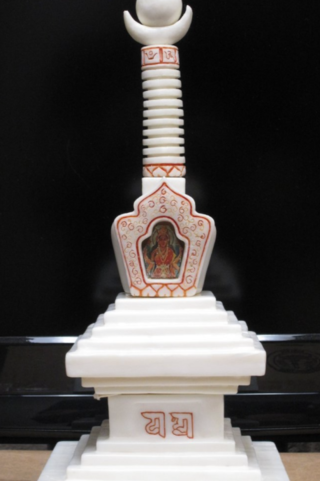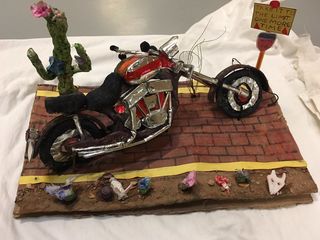Trust
Art Behind Bars: Animals, Compassion, Freedom, and Hope
A class at the Boulder County Jail inspires students to make positive changes.
Posted June 24, 2019
For many years, I have taught a class as part of the transitions program at the Boulder (Colorado) County Jail. It is a very unique one in which students are free to express themselves through art, prose, and poetry. This weekly gathering, for which they have to apply and be formally accepted, primarily focuses on animal behavior, conservation, and inmate well-being, among other topics. Over the past many years, it has been very successful in helping students discover unknown and untapped personal traits and skills that can be developed to help them eventually integrate into society, find a voice, and find connections in the inside and outside worlds. This drawing of Fifi, by one of my former students, Jeff, is one of numerous outstanding works. It won an award at an art festival to which I submitted it.

To celebrate almost 20 years of its existence, a website called Boulder Art Behind Bars was developed in collaboration with Stephanie Wencl, a devoted artisan and web designer compelled by nature. The recently launched site presents many different aspects of this inspirational class. I've been told that it has inspired other correctional institutions to try to develop similar ones. because nonhuman animals (animals) mean so much to numerous people who are incarcerated.
Boulder Art Behind Bars is also a part of Jane Goodall’s global Roots & Shoots program. Roots & Shoots promotes understanding of all cultures and beliefs and inspires individuals to take action to make the world a better place for people, other animals, and the environment. In October 2015, Dr. Goodall visited my class while she was in Boulder. She was able to see what the students accomplished and thought about, and they were very excited to listen to her lecture and to meet her up close and personal.

Many of the students find solace when they talk about animals and think about being outdoors. My class helps them learn to express themselves freely, it “softens” them, and also helps them find compassion for others. Examples of students' artwork and writing can be seen throughout the website, in a section called blog, and a number are presented here. (Also see "What Grinds My Gears," "The Healing Power of Animals: Moon Bear Has a Place, "Among Homeless People, Dogs Eat First and "Absorb Empathy," "Inmates and Art: Connecting With Animals Helps Soften Them," "Inmates, Animals, and Art: Creative Expressions of Hope," "Roots and Shoots: A unique program at Boulder County Jail has inmates learning from nature," and "Nature Behind Bars: Animal Class Helps Prisoners Find Compassion" for a discussion of my class and for examples of art and prose by students.)

Beyond the Art
Here I highlight a number of different aspects of my class and Boulder Art Behind Bars to show how it motivates students to tap into their many talents and to lay out a model for other correctional facilities. In a section called Beyond the Art, there are six different topics with accompanying artwork and prose: acceptance, self-confidence, integration, creativity and expression, Earth community connections, celebration and freedom, softening and vulnerability, and recovery, trust, forgiveness, and hope. A beautiful example of creativity and expression is a soap sculpture by Edward. This piece was made from tiny pieces of soap bars that were melted and molded in Edward’s hands. The paintbrushes were made from pieces of the artist’s hair attached to q-tips. The color came from various food items, such as pasta sauce, berries, and mustard. The sculpture was about 18” high and 6” at the base and took about three months to make. Edward called it a labor of love and continued to make more soap sculptures for the other inmates. Some of the students also made jewelry. In Earth community connections, there are watercolor paintings of flowers and a landscape.

In celebration and freedom, there's a motorcycle made by Gordon. He called it his "vehicle to freedom," and it was made from numerous items to which he had access in the module he shared with others. These included: HUBS: toothpaste caps and tops of tubes; RIMS: combs and cardboard; TIRES: folded edges of rags turned inside out—stuffed and dyed with colored pencils and shavings; FRAME: plastic spoon and a few dead tree twigs—covered with stained pieces of rags and toothpaste; ENGINE: shampoo container, toothpaste tubes for pistons, heads from bar soap, toothbrush handles, chip bags inside out for pipes and push rods, glue caps for air intake and battery; SEAT: cardboard wrapped with dyed rags and toothpaste; LIGHTS: caps wrapped in chip bags and candy wrappers for color; FORKS AND SHOCKS: pencils wrapped in chip bags inside out; WHEEL FENDERS: straps from old shoes dyed and plastic strips for shape; HANDLEBARS: dyed twigs wrapped in chip bags inside out; HAND GRIPS: foam earplugs; GAS TANK: deodorant containers; SIGNS: pencils, light cardboard, colored paper; CACTUS: tube edge of rags stuffed and dyed and toothpaste; FLOWERS: rags and toothpaste dyed to color; RABBIT: rags; TOP HAT: eraser wrapped in colored paper; SNAKE: wrapped up paper colored with toothpaste; SKULL: carved bar of soap; and ROADWAY: cardboard, black marker for line; brick-red colored pencil, lines yellow colored paper, road gravel and sand.

Many of the students take classes in anger management and conflict resolution. They learn to agree to disagree without argument that would take them nowhere. The students say that thinking about animals and how they care for one another helps to soften them, and teaches the value of empathy and compassion. In softening and vulnerability, there's a lovely drawing by Kyle Warner of chimpanzee mothers and their children.
Finally, in recovery, trust, forgiveness, and hope, we read a story of Asiatic moon bears who are tortured for their bile, many of whom are rescued and brought to one of Animals Asia's bear sanctuaries, where it is hoped they will eventually recover. Many do. Jasper’s story is a wonderful example. Jasper the bear was tortured and abused. He spent 15 years in a cage in which he could only move his head and neck, with a catheter stuck in his gallbladder from which bile was extracted. He recovered and became a peacemaker. He broke up fights among other bears, never missed a photo opportunity, and became my best friend.
Art Behind Bars also offers a “Road of Hope” for students. Another project involved writing a bilingual (English and Spanish) children’s book called the Book of Hope. The class and the students' artwork give them meaningful experiences, and in their drawings, sculptures, and writing, they express hope and trust. The work they do provides a forum for deep and informative discussions about other animals, nature, their connections to the outer world, and themselves.
Some success stories
I've also collected a number of success stories over the years. Here are a few. One student who was always reading “everything about dogs” became a dog trainer. Another student founded a group that helped other former inmates integrate back into society. One day as I was cycling through Boulder, someone called out, “Hey, Doctor Coyote!” and it turned out that he had been in my Roots & Shoots class and was determined to never re-enter corrections facilities. He had worked himself up to being a road manager for the Department of Transportation. And when Thomas was released from the Boulder County Jail after being incarcerated for many years there and in various other facilities, he got a job in a copy center. During his first year, he did excellent work and developed design and customer service skills. He became one of the most popular employees at this location.
One of the most user-friendly places for former students to find work is a local car wash in Boulder. They routinely hire people who have been incarcerated. One success story centers on a man who became an assistant manager and who beamed each time I came to get my car washed. Luis always was proud to tell me how well he was doing and was thrilled that his son was also working at the car wash and attending a local community college. In addition to working side-by-side at the car wash, Luis also decided to take classes at the same college.
Personal benefits from teaching this unique class
Teaching this class has been a two-way street. Over the years, I've benefited greatly from teaching these incredible students. My experience at the jail had positive effects on the way I taught at the University of Colorado. The students' enthusiasm and curiosity also helped me change some of the preconceived notions I had about inmates. Our discussions about topics including fairness, resilience, rehabilitation, retribution, compassion, freedom, justice, restorative justice, and hope were, at times, riveting. I also realized after only a few minutes in my first class years ago that the students really wanted to learn as much as they could about the lives of other animals and nature and to use this information to learn more about themselves and other humans. They also want to become a contributing member of society. I dedicated myself to working to “de-other” them, as we all worked together to get them ready for the "outside." In addition to many success stories, one student was so inspired by the class that he named his son after me. I was deeply touched by a letter he wrote to me after he was released to tell me that and to let me know he was "doing just fine."
Allowing inmates to express their feelings about animals can be beneficial for them
I hope this short journey through Boulder Art Behind Bars has inspired you to learn more about this unique program, some of the students, and the meaning of animals and nature to them. Among the many lessons I've learned are that uninformed stereotypes don't work, and there is always hope. I always leave the class with new insights and new ideas, and I hope other correctional facilities will follow suit and develop classes that focus on the lives of other animals and how learning and thinking about them can improve the lives of their residents.
Allowing inmates to express their feelings about animals can be beneficial for them and might help them on the outside. Many of the students feel this and say that discussions about animals and nature helped them keep their dreams alive. As we were developing Boulder Art Behind Bars, a number of students helped with content and organization, and some have told me they want to continue when they're released.
There's a lot of food for thought about how these relationships might help incarcerated individuals for counselors, social workers, psychiatrists, and conservation psychologists who work with these people. A few years ago, a counselor remarked to me how they were able to gain deeper access to one of the student's thoughts and feelings by talking about their relationships with other animals, why they missed these encounters, and how much they helped him when he was going through difficult times.
Stay tuned for updates to Boulder Art Behind Bars. It's a work in progress and will be updated as new material comes in. I look forward to leading this class for many years to come and to learning more about how inmates' feelings about other animals can help them along.




